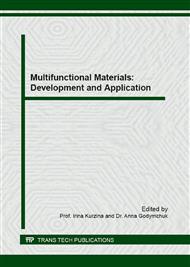[1]
Yu.P. Piryatinski, L.O. Dolgov, O.V. Yaroshchuk, S. Lazarouk, Fluorescence of porous silicon filled with liquid crystal 5CB, Mol. Cryst. Liq. Cryst. 467 (2007) 195-202.
DOI: 10.1080/15421400701221476
Google Scholar
[2]
U. Griming, V. Lehmann, S. Ottow, K. Busch, Macroporous silicon with a complete two-dimensional photonic band gap centered at 5 um, Appl. Phys. Lett. 68, 6 (1996) 747-749.
DOI: 10.1063/1.116729
Google Scholar
[3]
H. Saha, C. Pramanik, Porous silicon-based sensors: prospects and challenges, Materials and Manufacturing Processes 21 (2006) 239-246.
DOI: 10.1080/10426910500464461
Google Scholar
[4]
V.V. Bolotov, P.M. Korusenko, S.N. Nesov, S.N. Povoroznyuk, V.E. Roslikov, E.A. Kurdyukova, Yu.A. Sten'kin, R.V. Shelyagin, E.V. Knyazev, V.E. Kan, I.V. Ponomaryeva, Fabrication of por-Si/SnOx nanocomposite layers for gas microsensors and nanosensors, Semiconductors 45, 5 (2011).
DOI: 10.1134/s1063782611050071
Google Scholar
[5]
L.S. Monastyrskyi, O.I. Aksimentyeva, M.R. Pavlyk, V.P. Savchyn, L.I. Yaryc'ka, Organic-inorganic nanosystem based on fullerene embedded in porous silicon matrix, Mol. Cryst. Liq. Cryst. 536 (2011) 58-64.
DOI: 10.1080/15421406.2011.538338
Google Scholar
[6]
H. Foll, M. Leisner, A. Cojocaru, J. Carstensen, Macroporous semiconductors, Mater. 3 (2010) 3006-3076.
DOI: 10.3390/ma3053006
Google Scholar
[7]
V. Lehmann, Porous silicon matrix for chemical synthesis and chromatograpy, Phys. Stat. Sol. (A), 202, 8 (2005) 1365-1368.
DOI: 10.1002/pssa.200461103
Google Scholar
[8]
E. Quiroga-Gonzalez, J. Carstensen, C. Glynn, C. O'Dwyer, H. Foll, Pore size modulation in electrochemically etched macroporous p-type silicon monitored by FFT impedance spectroscopy and Raman scattering, Phys. Chemistry Chem. Physics 16, 1 (2014).
DOI: 10.1039/c3cp53600a
Google Scholar
[9]
R.B. Wehrspohn, Ordered Porous Nanostructures and Applications. Series: Nanostructure Science and Technology, Springer, New York, (2005).
Google Scholar
[10]
V. Torres-Costa, R.J. Martin-Palma, Application of nanostructured porous silicon in the field of optics. A review, J. Mater. Sci. 45 (2010) 2823-2838.
DOI: 10.1007/s10853-010-4251-8
Google Scholar
[11]
S.K. Lazaruk, A.V. Dolbik, V.A. Labunov, V.E. Borisenko, Combustion and explosion of nanostructured silicon in microsystem devices, Semiconductors 41, 9 (2007) 1113-1116.
DOI: 10.1134/s1063782607090175
Google Scholar
[12]
V. Lehmann, U. Gruing, The limits of macropore array fabrication, Thin Sol. Films 297 (1997) 13-17.
DOI: 10.1016/s0040-6090(96)09478-3
Google Scholar
[13]
A.A. Dmitrievskiy, N. Yu. Efremova, A.V. Druzhkin, T.O. Korosteleva, D.G. Guseva, Effect of the duration of electrochemical anodization on the microhardness of macroporous silicon, Semiconductors 48, 9 (2014) 1202–1204.
DOI: 10.1134/s1063782614090061
Google Scholar


